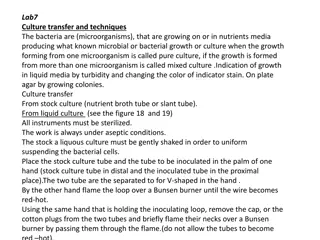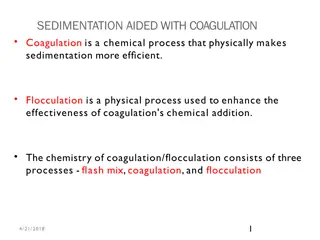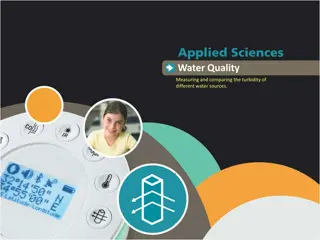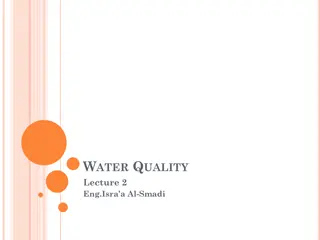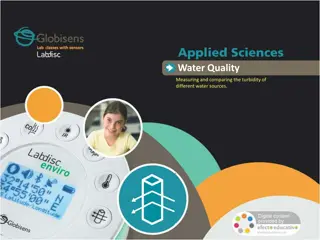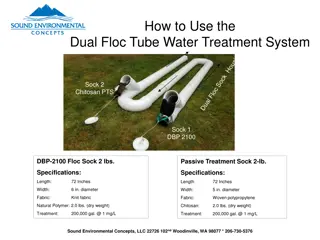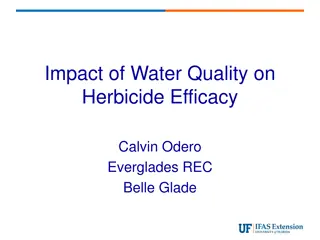Serco Business Illahee Tire Reef Cleanup Phase 2 Project Overview
Serco Business, in collaboration with Port of Illahee, is undertaking a tire reef cleanup project as mandated by regulatory requirements. The project involves removing clumps of tires near Illahee pier, evaluating water quality impacts, and establishing best practices for removal. The methodology in
0 views • 12 slides
Bacterial Culture Transfer Techniques and Growth Indicators
Bacterial cultures can be transferred using aseptic techniques to ensure purity. Growth indicators such as turbidity in liquid media and colonies on agar plates signify microbial growth. Proper sterilization and handling of instruments are crucial in the process. Techniques like streaking on agar pl
1 views • 4 slides
Methods for Determination of Microbial Growth
Quantitative determination of microbial growth is crucial for various purposes, with two commonly used methods being the standard plate count and spectrophotometric measurement. The standard plate count method estimates living microbial cell density, while spectrophotometric measurement relies on tu
2 views • 6 slides
Understanding Sedimentation Aided with Coagulation and Flocculation
Sedimentation aided with coagulation and flocculation is a chemical and physical process used in water treatment to efficiently remove impurities and particles. Coagulation involves adding chemicals to neutralize particles, while flocculation helps in forming larger clumps for easier removal. The en
1 views • 54 slides
Understanding Membrane Treatment in Water Filtration Systems
Membrane treatment plays a crucial role in water filtration systems by removing various contaminants such as turbidity, microbiology, and chemical impurities. This overview covers different types of membranes like plate and frame, spiral wound, tubular, and hollow fiber, highlighting their functions
0 views • 9 slides
Exploring Water Quality: Measuring Turbidity in Different Water Sources
This project focuses on comparing the turbidity of various natural and artificial water sources using the Labidsc turbidity sensor. The experiment aims to evaluate hypotheses and determine if there are differences in water quality between the samples. Understanding the impact of human activities on
4 views • 18 slides
Water Quality Monitoring and Procedures for Effective Environmental Management
This document outlines the monitoring tasks, water quality regulation, parameters to be monitored, sample collection locations, and procedures for on-site monitoring in a wastewater treatment facility. It covers essential aspects such as level of sludge and scum, TSS, TDS, BOD5, pH, COD, DO, nitroge
0 views • 9 slides
Jar Testing: A Comprehensive Overview of Procedures and Applications
Explore the world of Jar Testing through a detailed presentation encompassing topics like Jar Testing Application, Equipment/Tools, Protocol, Filterability Analysis, and Case Studies. Understand the importance of timely and efficient testing, optimal coagulant dosage, and building confidence in your
0 views • 48 slides
Water Supply Hazards and Management Insights
Understanding catchment hazards for water supplies is crucial for effective management. This report discusses E. coli values, turbidity concerns, fauna impact, and algal blooms. It also suggests measures to address these issues, such as riparian planting, stock management, and sediment control in ag
0 views • 10 slides
Understanding Water Quality Parameters and Characteristics
Water quality encompasses physical, chemical, and biological characteristics that determine its suitability for various uses. Physical parameters like turbidity, taste, odor, color, and temperature affect sensory perception. Chemical parameters such as pH, acidity, alkalinity, and hardness relate to
0 views • 26 slides
Water Quality - Measuring Turbidity of Different Water Sources
The activity involves comparing the turbidity of various natural and artificial water sources using a Labidsc turbidity sensor. Monitoring water quality is crucial for identifying pollutants, trends, and usage patterns in water resources. Factors like human activities affecting water quality through
0 views • 18 slides
Dual Floc Tube Water Treatment System with Chitosan PTS Sock DBP-2100
This system utilizes a Dual Floc Tube design incorporating Chitosan PTS Sock and DBP-2100 for effective water treatment. The specifications include a 72-inch length, 6-inch diameter, and a knit fabric construction. The natural polymer Chitosan is used in a dry weight of 2.0 lbs for treating 200,000
0 views • 4 slides
Understanding the Impact of Water Quality on Herbicide Efficacy
Water quality plays a crucial role in determining the effectiveness of herbicides. Factors such as water pH, hardness, turbidity, and dissolved materials can influence herbicide efficacy. The interaction between water chemistry and herbicide chemistry is essential for successful applications. Differ
0 views • 13 slides

